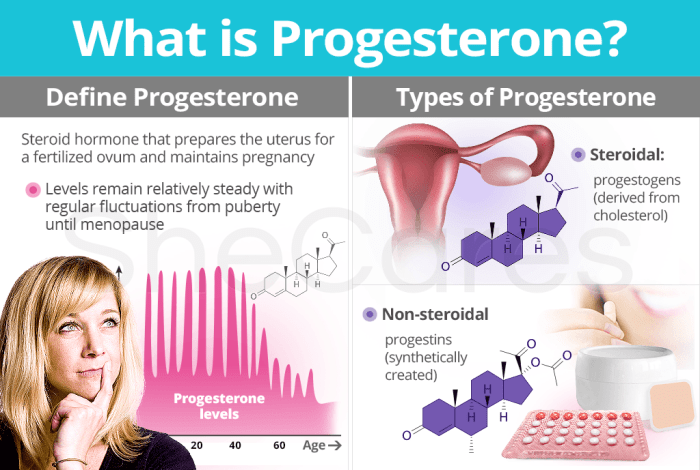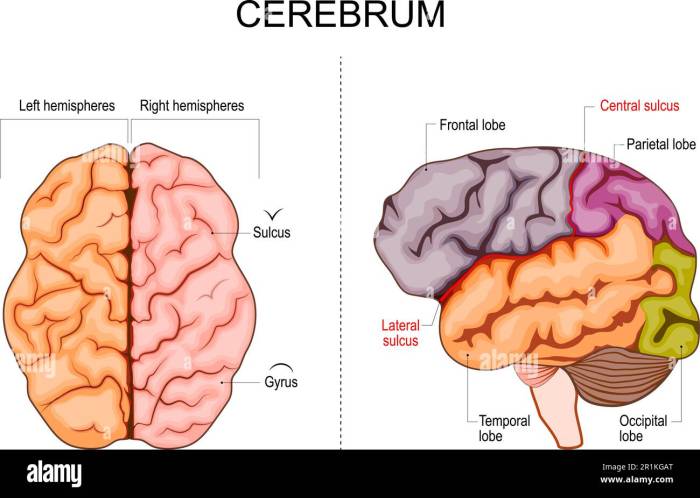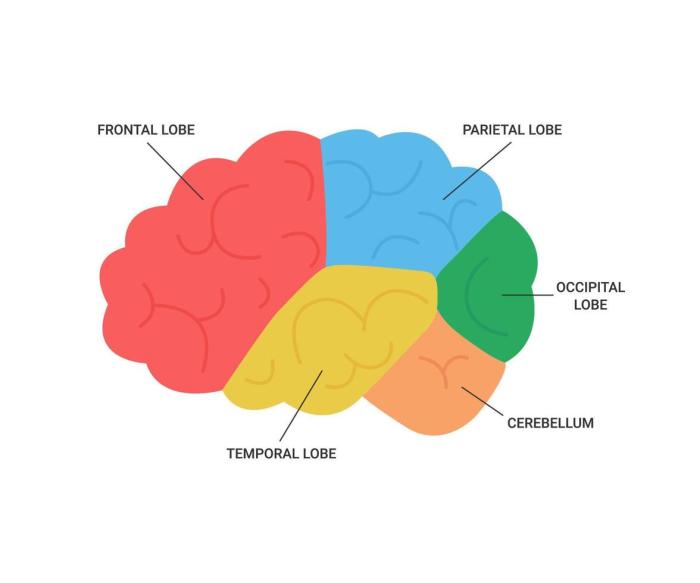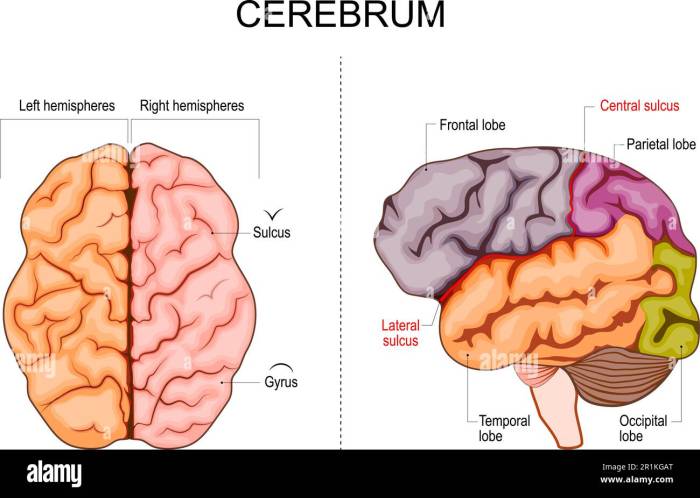Progesterone and brain health is a fascinating area of study. This exploration delves into the intricate relationship between progesterone, a vital hormone in the female body, and its impact on various aspects of brain function. From cognitive function and mood regulation to sleep patterns and even potential neuroprotective effects, progesterone’s influence is profound. We’ll examine how progesterone interacts with different brain regions and receptors, influencing everything from memory to stress responses.
Understanding progesterone’s diverse effects on the brain is crucial for comprehending its potential role in both normal brain function and in the context of neurological disorders. This article will discuss the scientific evidence behind progesterone’s interactions with the brain, exploring the potential benefits and risks of progesterone supplementation in different situations. We will also touch upon the clinical implications of these findings and highlight areas where further research is needed.
Introduction to Progesterone and the Brain
Progesterone, a steroid hormone primarily associated with female reproductive function, plays a surprisingly intricate role in brain health. While often overshadowed by estrogen, progesterone exerts significant influence on various cognitive functions and emotional regulation. Its presence in the brain, particularly in specific regions, highlights its importance beyond the reproductive system. Understanding progesterone’s interactions within the nervous system is crucial for comprehending its impact on mood, memory, and overall well-being.Progesterone’s presence in the brain is not simply a passive one; it actively modulates neurochemical signaling pathways, influencing everything from anxiety responses to sleep patterns.
This intricate interplay underscores the significance of maintaining balanced progesterone levels for optimal brain function. Understanding the receptors and pathways through which progesterone acts is essential for comprehending its impact on cognitive processes and emotional responses.
Progesterone Receptors in the Brain
Progesterone exerts its effects by binding to specific receptors within the brain. These receptors, categorized as progesterone receptor subtypes (PR-A and PR-B), are found in diverse brain regions. Understanding their location and function is crucial to comprehending the hormone’s influence on brain activity.
Progesterone and Neurochemical Interactions
Progesterone interacts with a variety of neurochemicals, including serotonin, dopamine, and GABA. These interactions influence various brain functions, including mood regulation, stress response, and memory consolidation. The precise mechanisms through which progesterone modulates these neurochemicals are still being investigated.
Progesterone’s Impact on Specific Brain Regions
Progesterone’s effects on the brain are not uniform across all regions. Different brain regions have varying concentrations of progesterone receptors and different sensitivity to the hormone. This leads to differential effects on cognitive processes and emotional states.
| Hormone | Receptor Type | Brain Region | Function |
|---|---|---|---|
| Progesterone | PR-A | Hippocampus | Plays a role in memory formation and spatial navigation |
| Progesterone | PR-B | Amygdala | Modulates anxiety and stress responses |
| Progesterone | PR-A/PR-B | Prefrontal Cortex | Affects attention, working memory, and decision-making |
| Progesterone | PR-A/PR-B | Hypothalamus | Regulates sleep-wake cycles and body temperature |
Progesterone and Cognitive Function
Progesterone, a crucial steroid hormone, plays a multifaceted role in the female body, extending far beyond its reproductive functions. Its influence on the brain is a growing area of research, and its potential impact on cognitive function is particularly intriguing. This exploration delves into the potential effects of progesterone on memory, learning, and attention, examining variations across the lifespan and potential mechanisms.Understanding how progesterone impacts cognitive processes is vital for developing strategies to support optimal brain health throughout a woman’s life.
Progesterone plays a crucial role in maintaining brain health, impacting mood and cognitive function. While exploring the potential benefits of progesterone for the brain, it’s important to remember that over-the-counter medications like Benadryl, which you can learn more about at benadryl what you should know , can also affect brain chemistry. Ultimately, understanding the complex interplay between hormones and brain health is key for informed decisions about your well-being.
While more research is needed, the current evidence suggests a complex relationship between progesterone and various cognitive domains, with fluctuations during the menstrual cycle potentially playing a significant role.
Progesterone’s Influence on Memory
Progesterone’s effects on memory are not uniform across the lifespan. In some studies, progesterone has shown a positive correlation with certain types of memory, particularly episodic memory (remembering specific events). However, this relationship can be modulated by other factors like estrogen levels and the specific phase of the menstrual cycle. Furthermore, research indicates that the effects of progesterone on memory may be more pronounced during specific developmental stages, such as adolescence or perimenopause, when hormonal fluctuations are significant.
Progesterone’s Influence on Learning
Learning, like memory, isn’t a monolithic function but involves various processes. Progesterone’s potential impact on learning likely intersects with its influence on synaptic plasticity (the brain’s ability to change connections). Some studies suggest that progesterone may enhance the consolidation of newly acquired information. However, this impact may also be influenced by factors like the specific type of learning task, the individual’s hormonal status, and overall health.
Progesterone’s Influence on Attention
Attention is a complex cognitive function, encompassing various aspects like focus, sustained attention, and selective attention. Studies exploring progesterone’s role in attention have yielded mixed results, with some suggesting potential improvements in certain aspects of attentional control during specific phases of the menstrual cycle. However, further research is needed to fully understand the nuances of this relationship and its potential impact across the lifespan.
Progesterone and Cognitive Function Across the Lifespan
The impact of progesterone on cognitive function is likely to differ across the lifespan due to variations in hormonal profiles and the developmental stage of the brain. During adolescence, fluctuating hormones might influence cognitive development and learning processes. In adulthood, the relationship between progesterone and cognitive performance might be influenced by other hormonal factors, like estrogen, and the individual’s overall health.
Menopause, characterized by significant hormonal changes, could also influence cognitive functions, potentially impacting memory, learning, and attention.
Potential Mechanisms Behind Progesterone’s Influence, Progesterone and brain health
Progesterone’s influence on cognitive function is likely mediated through various mechanisms within the brain. One potential mechanism involves its interaction with neurotransmitter systems, potentially influencing the release or uptake of neurochemicals like dopamine or serotonin. Furthermore, progesterone may play a role in modulating synaptic plasticity and neuronal growth, impacting the brain’s structural and functional capacity.
Menstrual Cycle and Cognitive Function
The table below illustrates the potential impact of progesterone on different cognitive domains throughout the menstrual cycle.
Progesterone’s role in brain health is fascinating, but navigating the complexities of chemo can be daunting. Knowing what to expect before your first chemo treatment, like the primer tips before your first chemo treatment , is crucial. Understanding how these treatments might affect hormone levels, including progesterone, is essential for long-term brain health and well-being.
| Menstrual Cycle Phase | Potential Impact on Memory | Potential Impact on Learning | Potential Impact on Attention |
|---|---|---|---|
| Follicular Phase | Possible enhancement of episodic memory | Potential facilitation of learning | Potential improvement in selective attention |
| Ovulatory Phase | Variable effects, potentially positive | Variable effects, potentially positive | Variable effects, potentially positive |
| Luteal Phase | Potential enhancement of certain memory types | Potential facilitation of learning | Potential fluctuations in attentional control |
Note: This table represents potential effects and is not definitive. Individual experiences and responses may vary.
Progesterone and Mood Regulation
Progesterone, a crucial steroid hormone, plays a multifaceted role in the human body, extending far beyond its well-known involvement in reproduction. Its influence on mood and emotional responses is a significant aspect of its physiological impact. This exploration delves into the complex interplay between progesterone levels and mood fluctuations, examining potential links to anxiety, depression, and stress responses.Progesterone’s influence on mood is not a simple cause-and-effect relationship; instead, it’s intricately woven into the complex tapestry of neurotransmitter activity and hormonal interactions.
The hormone’s influence is most apparent during times of fluctuation, such as menstruation and pregnancy. Understanding these fluctuations is key to appreciating the connection between progesterone and emotional well-being.
Progesterone Fluctuations and Mood Changes
Progesterone levels naturally fluctuate throughout the menstrual cycle. These fluctuations correlate with noticeable changes in mood. During the follicular phase, progesterone levels are relatively low, and women might experience a range of emotions, from heightened energy and focus to feelings of irritability or anxiety. As progesterone levels increase during the luteal phase, women might experience feelings of calmness, relaxation, and even heightened empathy.
These shifts are often subtle but can significantly impact daily experiences. This natural fluctuation is a biological process, and it’s essential to acknowledge its influence on mood regulation.
Potential Connections to Anxiety, Depression, and Stress
Progesterone’s influence on mood extends to its potential role in regulating stress responses. Studies suggest that adequate progesterone levels may help buffer the negative effects of stress on the brain. This potential benefit is tied to the hormone’s influence on neurotransmitters like serotonin and dopamine, which play critical roles in mood regulation. Conversely, inadequate progesterone levels may increase vulnerability to anxiety and depressive symptoms, especially during periods of hormonal fluctuation.
Studies Examining Progesterone and Mood
Numerous studies have investigated the relationship between progesterone and mood. One notable area of research has focused on the impact of progesterone supplementation on women experiencing premenstrual syndrome (PMS) symptoms. Results have shown mixed outcomes, with some studies indicating potential benefits in reducing symptoms like irritability and anxiety, while others have reported minimal or no effects. The variability in study results may be due to factors such as dosage, timing of supplementation, and the specific symptoms being evaluated.
Further research is needed to clarify the role of progesterone supplementation in managing mood-related symptoms.
Summary Table: Mood Symptoms and Potential Progesterone Correlation
| Mood-Related Symptom | Possible Progesterone Correlation |
|---|---|
| Irritability | Potentially linked to low progesterone levels, particularly during the follicular phase of the menstrual cycle. |
| Anxiety | Low progesterone levels may increase vulnerability to anxiety, potentially through its influence on neurotransmitter activity. |
| Depression | Inadequate progesterone levels may contribute to depressive symptoms, especially during periods of hormonal fluctuation. |
| Increased energy/focus | May be observed during periods of lower progesterone levels. |
| Calmness/Relaxation | Associated with higher progesterone levels, often observed during the luteal phase. |
Note: This table presents potential correlations, not definitive causal relationships. Individual experiences may vary.
Progesterone and Brain Structure and Development
Progesterone, a steroid hormone, plays a multifaceted role in the intricate workings of the human brain. Beyond its impact on mood and cognitive function, progesterone exerts significant influence on brain structure and development, impacting neural networks and potentially shaping the brain’s architecture throughout life. Understanding this influence is crucial for comprehending the hormonal interplay that molds brain function.Progesterone’s effects on the brain are not uniform throughout life.
Its impact varies considerably depending on the stage of development and the specific hormonal milieu, with the interplay between estrogen and progesterone being especially important. This intricate hormonal dance significantly affects brain plasticity and neurogenesis, thereby influencing brain structure. Understanding these dynamic relationships is key to appreciating the diverse roles progesterone plays in brain health across the lifespan.
Potential Influence on Brain Structure and Development
Progesterone exerts its influence on brain development by interacting with specific receptors within the brain’s neural structures. Studies suggest that progesterone influences the development of key brain regions, including the hippocampus, amygdala, and prefrontal cortex. These regions are critical for memory, emotion processing, and executive functions. The precise mechanisms by which progesterone modulates neuronal growth and differentiation remain a focus of ongoing research.
Differences in progesterone levels during critical periods of development may contribute to variations in brain structure and function across individuals.
Effects on Neural Plasticity and Neurogenesis
Neural plasticity, the brain’s ability to reorganize itself by forming new neural connections, is a critical aspect of learning and memory. Progesterone plays a significant role in regulating this dynamic process. It can modulate the expression of genes involved in neuronal growth and survival, thereby influencing the brain’s capacity for adaptation and change. Neurogenesis, the creation of new neurons, is also potentially influenced by progesterone levels.
Fluctuations in progesterone, particularly during crucial developmental stages, might impact the rate and extent of neurogenesis, impacting the brain’s overall capacity for learning and adaptation.
Impact of Fluctuating Progesterone Levels Across the Lifespan
Progesterone levels fluctuate throughout the lifespan, with notable changes during puberty, pregnancy, and menopause. These fluctuations can have varying impacts on brain structure and function. For instance, during puberty, the surge in hormones including progesterone can influence the development of emotional centers in the brain. During pregnancy, progesterone levels significantly increase, potentially impacting the developing fetal brain.
Menopause, marked by a decrease in estrogen and progesterone, can lead to structural changes in certain brain regions. These changes can potentially impact cognitive function, mood regulation, and memory.
Table: Comparing and Contrasting Brain Structure Across Hormonal Fluctuation Stages
| Stage of Life | Estrogen Level | Progesterone Level | Potential Impact on Brain Structure |
|---|---|---|---|
| Puberty | Increasing | Increasing | Development of emotional centers, potential impact on neuronal connections in limbic system. |
| Pregnancy | Increasing | Significantly increasing | Possible structural changes related to maternal caregiving, impact on cognitive function remains under study. |
| Menopause | Decreasing | Decreasing | Potential shrinkage in certain brain regions, impact on memory and cognitive function is a subject of ongoing investigation. |
Progesterone and Neurological Disorders
Progesterone, a vital steroid hormone, exerts influence beyond its reproductive roles. Emerging research suggests a potential protective effect of progesterone in various neurological disorders, offering avenues for potential therapeutic interventions. This exploration delves into the possible mechanisms by which progesterone might mitigate neurological damage and its potential role in conditions like Alzheimer’s, Parkinson’s, and stroke.Understanding progesterone’s impact on the brain’s health in these conditions is crucial, as it may offer a novel approach to managing and potentially preventing neurological damage.
Potential Protective Roles in Neurological Disorders
Progesterone’s involvement in neuronal survival and function hints at its possible therapeutic benefits in neurological disorders. It may influence neuroinflammation, oxidative stress, and apoptosis (programmed cell death), all factors implicated in the progression of several neurodegenerative diseases. Furthermore, its interaction with other neuroprotective molecules could amplify its beneficial effects.
Conditions Where Progesterone Might Play a Role
Several neurological disorders show promise for potential progesterone intervention. The following conditions are examples where research suggests progesterone might play a role:
- Alzheimer’s Disease: Research indicates that progesterone may help protect against the accumulation of amyloid plaques and tau tangles, key pathological hallmarks of Alzheimer’s. Some studies suggest progesterone may enhance the function of cholinergic neurons, vital for memory and cognitive function. This protection is attributed to progesterone’s anti-inflammatory and antioxidant properties. Evidence suggests progesterone may improve cognitive function in individuals with Alzheimer’s.
- Parkinson’s Disease: Progesterone may potentially offer neuroprotection against the loss of dopaminergic neurons, a defining feature of Parkinson’s disease. The antioxidant and anti-inflammatory properties of progesterone could play a significant role in mitigating oxidative stress and neuroinflammation, both implicated in Parkinson’s progression. Some studies have suggested a positive correlation between progesterone levels and motor function in Parkinson’s patients.
- Stroke: Progesterone may exert neuroprotective effects following stroke. This is potentially due to its ability to reduce oxidative stress and inflammation, which contribute to neuronal damage after a stroke. Evidence suggests progesterone can potentially limit the extent of brain injury after a stroke.
Mechanisms of Mitigation
Several potential mechanisms underpin progesterone’s neuroprotective actions. These mechanisms include:
- Anti-inflammatory effects: Progesterone’s ability to modulate the inflammatory response could limit the damage to brain cells associated with various neurological disorders.
- Antioxidant properties: Progesterone’s antioxidant activity could help to combat the damaging effects of free radicals, which contribute to the progression of many neurological diseases.
- Neurotrophic support: Progesterone may promote the growth and survival of neurons, potentially counteracting the neuronal loss characteristic of several neurological disorders.
- Modulation of neurotransmitter systems: Progesterone may influence the balance of neurotransmitters in the brain, potentially contributing to improved cognitive function and mood regulation.
Research Summary Table
| Condition | Potential Effects of Progesterone | Relevant Research |
|---|---|---|
| Alzheimer’s Disease | Possible protection against amyloid plaques and tau tangles, enhanced cholinergic function, improved cognitive function | Numerous studies exploring progesterone’s effects on cognitive function and amyloid-beta aggregation in animal models and preliminary human trials. |
| Parkinson’s Disease | Potential neuroprotection against dopaminergic neuron loss, reduction of oxidative stress and inflammation, improvement in motor function | Limited clinical trials investigating progesterone’s impact on motor symptoms and neuroprotective effects in Parkinson’s patients. |
| Stroke | Reduction of oxidative stress and inflammation, limitation of brain injury | Studies exploring progesterone’s impact on stroke outcomes in animal models and preliminary human studies. |
Progesterone and Stress Response
Progesterone, a vital steroid hormone, plays a multifaceted role in the body, extending beyond reproduction. Its influence on the stress response system is a crucial aspect of overall health. Understanding this interaction is important for comprehending how progesterone can mitigate the negative impacts of stress on the body and mind.Progesterone’s influence on the stress response is complex, acting as both a potential buffer and a modulator.
It interacts with other hormones in the hypothalamic-pituitary-adrenal (HPA) axis, a key component of the body’s stress response. Its impact on neurotransmitter systems and brain structure further contributes to its role in stress management.
Progesterone’s Interaction with the Stress Response System
Progesterone’s interaction with the stress response system is multifaceted. It can influence the release of stress hormones like cortisol and adrenaline, and its impact varies across different stress types. This interaction is not always straightforward, as individual responses to stress can be significantly affected by factors like genetics, diet, lifestyle, and other hormonal imbalances.
How Progesterone May Influence the Body’s Reaction to Stress
Progesterone’s effect on the stress response is often protective. It can help to reduce the overactivation of the HPA axis, which is crucial in mitigating the long-term consequences of chronic stress. Studies have shown that progesterone can modulate the activity of receptors for stress hormones, potentially reducing the body’s physiological response to stressful stimuli. It can also influence the production and function of neurotransmitters, such as serotonin and GABA, which play crucial roles in mood regulation and stress response.
Progesterone plays a fascinating role in brain function, influencing mood and cognitive processes. However, understanding its intricate relationship with conditions like atypical ductal hyperplasia of the breast here is crucial. While the exact mechanisms aren’t fully understood, research suggests a potential interplay between hormonal imbalances and breast health, which, in turn, could indirectly impact brain function.
Further study into these connections is essential for a more comprehensive understanding of progesterone’s impact on overall well-being.
Progesterone’s Interaction with Other Stress Hormones
Progesterone’s interactions with other stress hormones are complex and not fully understood. It may work synergistically with some hormones, while potentially opposing the effects of others. For instance, progesterone may act to dampen the cortisol response to stress, providing a protective effect. Conversely, its interaction with adrenaline may be more nuanced, potentially altering the body’s overall response to acute stressors.
This intricate interplay highlights the multifaceted role of progesterone in the body’s stress response mechanisms.
Types of Stress, Progesterone Response, and Potential Outcomes
| Stress Type | Progesterone Response (Potential) | Potential Outcomes |
|---|---|---|
| Acute Stress (e.g., public speaking, sudden noise) | May help modulate the adrenaline response, potentially reducing the intensity of the immediate physiological reaction. | Reduced heart rate elevation, lessened anxiety symptoms, faster recovery from the stressor. |
| Chronic Stress (e.g., financial difficulties, relationship problems) | May help dampen the chronic cortisol elevation, reducing the long-term physiological and psychological effects. | Lower risk of developing stress-related disorders (e.g., anxiety, depression), improved sleep quality, enhanced immune function. |
| Emotional Stress (e.g., grief, fear, trauma) | May influence neurotransmitter systems, potentially supporting emotional regulation and reducing emotional distress. | Improved emotional stability, reduced feelings of anxiety and depression, better coping mechanisms. |
| Physical Stress (e.g., injury, surgery) | May help reduce the inflammatory response associated with physical stress, potentially improving recovery. | Faster healing, reduced pain perception, improved immune system function during recovery. |
“Progesterone’s role in stress management is multifaceted and warrants further investigation, particularly in the context of chronic stress and its impact on overall health.”
Progesterone and Sleep

Progesterone, a crucial steroid hormone, plays a multifaceted role in the body, influencing numerous physiological processes, including sleep. Its impact on sleep is not a simple on-off switch, but rather a complex interplay with other neurochemicals and hormonal systems. Understanding this intricate relationship can shed light on the potential connection between progesterone fluctuations and sleep disturbances.Progesterone’s effects on sleep are intricately linked to its influence on various neurochemicals and brain regions associated with sleep regulation.
The hormone’s levels fluctuate throughout the menstrual cycle, which, in turn, can affect sleep patterns and quality. These fluctuations can contribute to sleep disturbances, especially during periods of low progesterone. In contrast, periods of higher progesterone can potentially lead to improved sleep.
Potential Impact on Sleep Cycles
Progesterone’s influence on sleep cycles is not fully understood, but its effects on neurochemicals such as GABA and melatonin are likely crucial. GABA is a neurotransmitter known for its calming effects, and progesterone’s interaction with GABAergic systems could potentially promote relaxation and sleep initiation. Similarly, progesterone’s possible modulation of melatonin, a hormone crucial for regulating the sleep-wake cycle, could also contribute to improved sleep quality.
Potential Interactions with Other Neurochemicals
Progesterone’s interaction with other neurochemicals like serotonin and dopamine, crucial for mood regulation and sleep, is another significant aspect of its impact on sleep. Serotonin, for example, is implicated in sleep onset and maintenance. Progesterone may influence the availability or activity of serotonin receptors, thus indirectly affecting sleep. Similarly, dopamine’s role in sleep-wake cycles and REM sleep could also be modulated by progesterone.
Sleep Stages and Potential Progesterone Influences
Understanding how progesterone might affect different sleep stages is crucial. While research is ongoing, a possible influence can be observed in the following table:
| Sleep Stage | Potential Progesterone Influence |
|---|---|
| Wakefulness | Potential modulation of alertness and arousal, possibly influenced by its interaction with other neurochemicals like norepinephrine. |
| Non-Rapid Eye Movement (NREM) Sleep | Potentially promotes relaxation and deep sleep through interaction with GABAergic systems and possible impact on sleep spindles. |
| Rapid Eye Movement (REM) Sleep | Possible influence on REM sleep duration and quality, potentially related to its interaction with neurochemicals like serotonin and dopamine. Further research is required. |
“It is important to note that the exact mechanisms by which progesterone influences sleep are still being investigated. More research is needed to fully elucidate these complex interactions.”
Progesterone and Neuroprotection: Progesterone And Brain Health
Progesterone, a crucial steroid hormone, plays a multifaceted role in maintaining brain health. Beyond its effects on mood and cognitive function, progesterone demonstrates remarkable neuroprotective properties, shielding brain cells from damage and potentially mitigating the progression of neurological disorders. This protective function stems from various mechanisms, which we’ll explore in detail.Progesterone’s neuroprotective actions are not fully understood, but emerging research suggests it acts as a shield against a range of insults that can harm the brain.
It’s thought to reduce oxidative stress, promote neuronal survival, and potentially prevent neuronal death in various pathological conditions. This protective effect is likely a complex interplay of different molecular mechanisms.
Potential Mechanisms of Progesterone’s Neuroprotective Actions
Progesterone exerts its neuroprotective effects through a variety of pathways. These include its anti-inflammatory actions, its antioxidant properties, and its role in promoting neuronal survival. It’s believed to work in concert with other neuroprotective agents to combat neuronal damage and potentially slow the progression of neurodegenerative processes. These actions are likely multifaceted and involve numerous intracellular signaling cascades.
Examples of Progesterone’s Neuroprotective Effects
Numerous studies suggest that progesterone can protect neurons from damage caused by various factors. For instance, in animal models of stroke, progesterone administration has been shown to reduce the extent of brain damage and improve neurological function. Similarly, in studies examining the effects of aging on the brain, progesterone has demonstrated potential benefits in maintaining cognitive function and preserving brain structure.
This suggests a wide-ranging protective capacity, extending to various conditions that affect the brain.
Neuroprotective Mechanisms of Progesterone
Understanding the specific mechanisms behind progesterone’s neuroprotective actions is crucial for developing effective strategies to mitigate neurological damage. The following table Artikels some of the key neuroprotective mechanisms of progesterone:
| Mechanism | Description | Examples of Evidence |
|---|---|---|
| Antioxidant Activity | Progesterone scavenges free radicals and reduces oxidative stress, a key contributor to neuronal damage. | Studies showing reduced oxidative stress markers in the brain following progesterone treatment. |
| Anti-inflammatory Effects | Progesterone modulates inflammatory responses in the brain, reducing inflammation which can be detrimental to neurons. | Studies showing reduced inflammatory markers in animal models of neurological disorders following progesterone administration. |
| Promoting Neuronal Survival | Progesterone can directly promote the survival of neurons by influencing the expression of genes involved in cell survival. | Studies showing increased neuronal survival and reduced apoptosis (programmed cell death) in response to progesterone treatment. |
| Modulation of Neurotrophic Factors | Progesterone may influence the production or activity of neurotrophic factors, which are crucial for neuronal growth and survival. | Studies linking progesterone to changes in the expression or activity of factors like BDNF (brain-derived neurotrophic factor). |
| Protection Against Neuronal Excitotoxicity | Progesterone can protect neurons from damage caused by excessive stimulation (excitotoxicity). | Studies showing reduced neuronal damage in animal models of excitotoxic injury following progesterone administration. |
Clinical Implications and Future Directions

Progesterone’s multifaceted effects on brain health offer exciting possibilities for therapeutic interventions. Understanding its intricate relationship with various neurological processes opens doors to potentially improve cognitive function, mood regulation, and overall well-being. However, translating this knowledge into effective clinical applications requires careful consideration of potential benefits and risks. This section explores the potential clinical implications, therapeutic applications, and crucial research areas in this burgeoning field.
Potential Therapeutic Applications
Progesterone’s influence on neurotransmission, neuronal plasticity, and neuroprotection suggests potential therapeutic applications across a spectrum of neurological conditions. These potential applications are not yet widely implemented due to ongoing research and the need for rigorous clinical trials. For example, in women experiencing perimenopausal or menopausal symptoms, progesterone supplementation could potentially mitigate cognitive decline and mood swings, though more research is needed.
Research Areas Needing Further Investigation
Further research is essential to solidify the clinical implications of progesterone supplementation. Several critical areas require investigation to fully understand the complexities of progesterone’s action in the brain. These areas include:
- Defining optimal dosage and delivery methods: Determining the precise dosage and most effective delivery methods (e.g., oral, transdermal) for specific conditions is crucial. Different formulations and routes of administration may influence the brain’s response to progesterone.
- Investigating long-term effects: Long-term safety and efficacy studies are essential to assess the potential cumulative impact of progesterone supplementation over extended periods. Observational studies are required to identify and address potential side effects.
- Personalized medicine approaches: Tailoring progesterone supplementation strategies based on individual genetic profiles and specific neurological needs could enhance efficacy and minimize risks. Identifying specific genetic markers that influence the brain’s response to progesterone could lead to personalized treatment plans.
- Addressing potential interactions: Investigating potential interactions between progesterone and other medications or supplements is vital. This includes identifying potential drug-drug interactions and exploring the interplay with other hormones or neurotransmitters.
Potential Clinical Applications Table
| Potential Clinical Application | Potential Benefits | Potential Risks |
|---|---|---|
| Cognitive Enhancement (Mild Cognitive Impairment) | Improved memory, attention, and executive function. Potentially slows the progression of cognitive decline. | Potential for side effects like mood swings, breast tenderness, and nausea. Individual responses may vary. |
| Mood Regulation (Perimenopause/Menopause) | Reduction in anxiety and depression symptoms associated with hormonal fluctuations. | Potential for side effects like headaches, bloating, and changes in libido. Not all individuals will respond positively. |
| Neuroprotection (Neurodegenerative Diseases) | Potentially slows disease progression and reduces neuronal damage in conditions like Alzheimer’s disease and Parkinson’s disease. | Long-term safety and efficacy in neurodegenerative diseases remain largely unproven. Further research is crucial. |
| Stress Response Modulation | Potential reduction in stress-related symptoms. | Potential for mood swings and sleep disturbances. |
Last Word
In conclusion, the interplay between progesterone and brain health is complex and multifaceted. This article has highlighted the diverse ways progesterone affects cognitive function, mood, stress responses, and even sleep. While the potential benefits are intriguing, further research is essential to fully understand the mechanisms and establish clear clinical applications. This complex relationship underscores the importance of individual variations and the need for careful consideration when exploring potential therapeutic interventions.






















